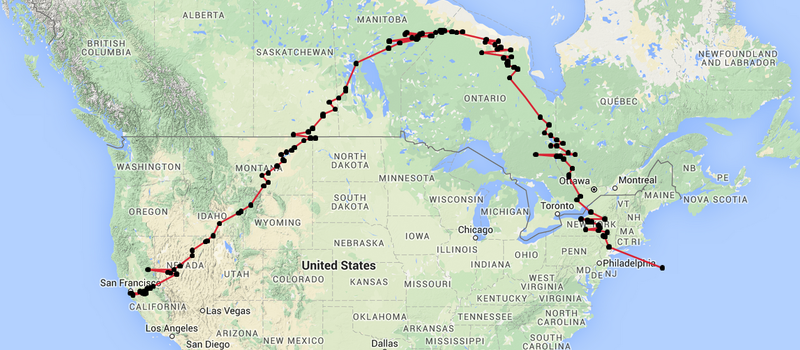High-altitude balloon flights have become somewhat of a known quantity these days. Although it’s still a fun project that’ll bring your hackerspace together on a complex challenge, after the first balloon or two, everyone starts to wonder”what next?”. Higher? Faster? Further? Cheaper? More science? There are a variety of different challenges out there.
A group of Stanford students just bagged a new record, longest time in flight, with their SSI-41 mission. In addition to flying from coast to coast, on a track that went waaaay up into Canadian airspace, they logged 79 hours of flight time.
 The secret? Val-Bal. A “valve ballast” gas venting valve and ballast dispenser system that kept the balloon from going too high (and popping) or dropping back down to earth. The balance seems to have worked nearly perfectly — check the altitude profile graph. We’d love to see more details about this system. If anyone out there on the team does a writeup, let us know?
The secret? Val-Bal. A “valve ballast” gas venting valve and ballast dispenser system that kept the balloon from going too high (and popping) or dropping back down to earth. The balance seems to have worked nearly perfectly — check the altitude profile graph. We’d love to see more details about this system. If anyone out there on the team does a writeup, let us know?
There are as many interesting ways to get into high-altitude ballooning as there are hackers. We love the extreme economy of the Pico Space Balloon project, which has gone around the world (twice!) on a solar-powered party balloon. And we’ll give both the best-name and ridiculous-concept awards to the Tetroon. But for now, most time aloft goes to the Stanford team. Congrats!
[via the Bangor Daily News, if you can believe that]

















So the record is for latex balloons, not any balloon as plenty of other balloons have beaten 79 hours.
Valve and ballast systems are commercially available: https://swsdt.com/products/ . This is still a great accomplishment. See Alan’s comments below about records. Also note, the Stanford students are posting similar statements on their site ” At this point, the payload had surpassed 57 hours and 2 minutes aloft, the previous world record for latex balloon fight time, set by the California Near Space Project’s CNSP-11 launch. ” – from http://stanfordssi.org/blog/balloons/85-ssi-41-crosses-continental-us-breaks-world-record
What about those Japanese balloon bombs from World War II?
There does not seem to be any significant technology in this thing.
Quote:
ValBal, short for “Valve-Ballast” is a novel platform developed by the SSI Balloons team that utilizes a gas venting valve and a ballast dispenser to zero its ascent rate and maintain a nearly constant altitude.
I would be impressed if they made a system to compress the gas & store it for later release to controll the altitude.
First thought was a mechanical pump / battery combination, but that would need a heavy high pressure container.
Second thought. This might be a very good application for fuel cells.
Fill the balloon with hydrogen (if it burns like the hindenburg nobady cares & 10km Height). And instead of compressing the hydrogen, you can burn it and store the water for ballast.
Add some solar cells / batery combination to decompose the water and generate a closed cyle.
Now I wonder, has this been done before?
I wondered about this as well. I read the article at the SSI-41 link above and they said that it, “either vented gas or dropped ballast.” Now I get it. The baloon lofts with a fixed amount of gas. Obviously, the scheme will only function properly for a fixed number of cycles — the more gas and ballast you start with, the more cycles you get. It is clever though.
Commercially available valve & ballast systems exist, but this is very impressive from SSI! : https://swsdt.com/products/ . See Alan’s comments here about records. Hi Alan :)
I’ll just leave this here: https://zerogees.wordpress.com/2015/11/25/andy-nguyen-balloon-record/
or http://qrp-labs.com/flights/s18.html
Boom.
Not a patch on the 100 days of this previously mentioned balloon!
http://hackaday.com/2014/10/19/high-altitude-balloon-keeps-going/
Although that was admittedly an accident…
OK, I see comments about balloons going around the globe twice and another balloon staying up for more then 100 days? So now I’m very confused about the record claim, is this serious or just a way to attract attention? What is the exact definition of the record claimed here?
I really want to know (a record is a serious thing and should not be joked about).
you could read the article, and maybe do a search or two…
Record? I suspect you didn’t do your homework. Even on Latex that duration was beat a number of years ago by the CNSP group. And if we add plastic into the equation, 79hr fails by comparison to over 141 days for another CNSP project as well a number of other people who have flown around the world on a number of circumnavigations. In fact there are 3 currently flying balloons, one from the UK and the UBSEDS group and 2 of my own (up over 90 days on one and close to 60 on the other). All at similar altitudes – between 12-16km all super pressure (means basically they stay at a constant altitude with no other mechanical help).
Ya need to get your facts straight before making such claims
Great project :)
But hang on, what about the one that went around the world twice! Why was this not on the news??? It flew abound the world TWICE FFS!!!! Makes that solar aeroplane from a couple months ago look a bit weak… ;)